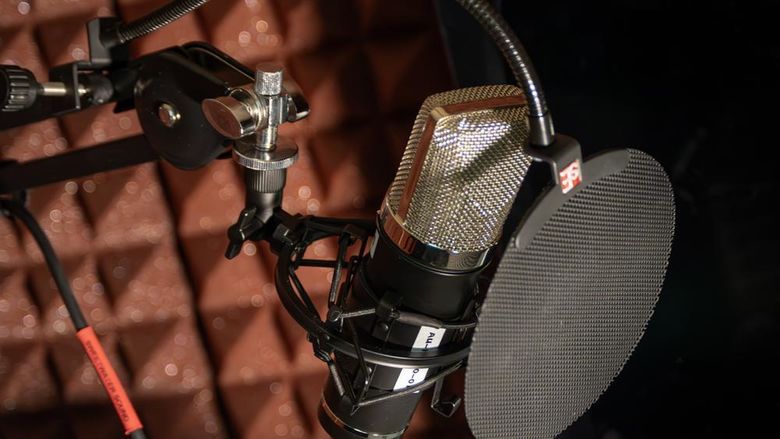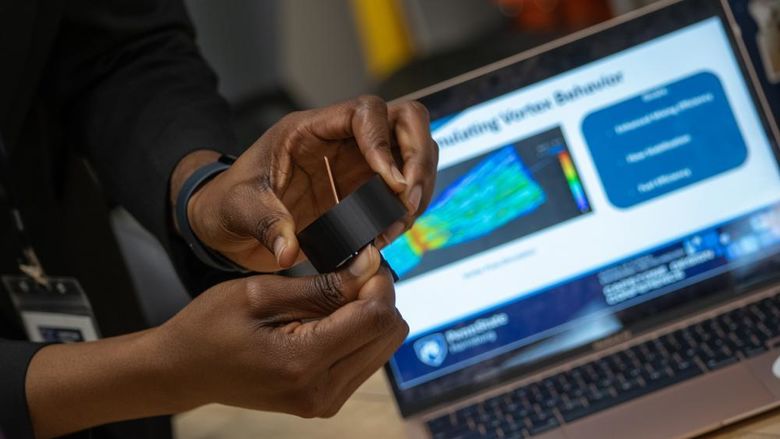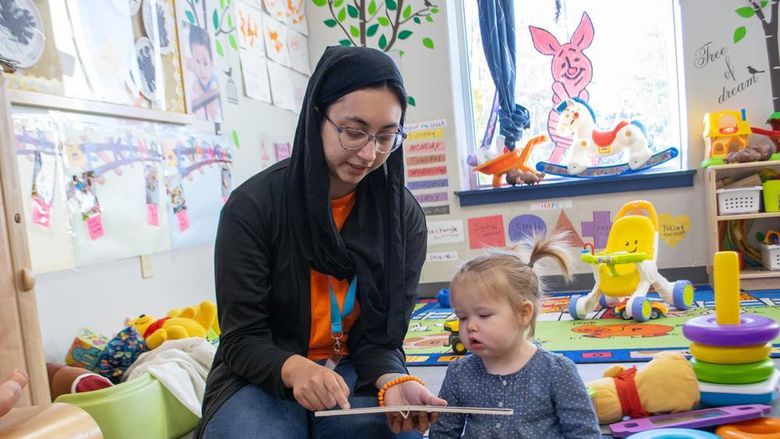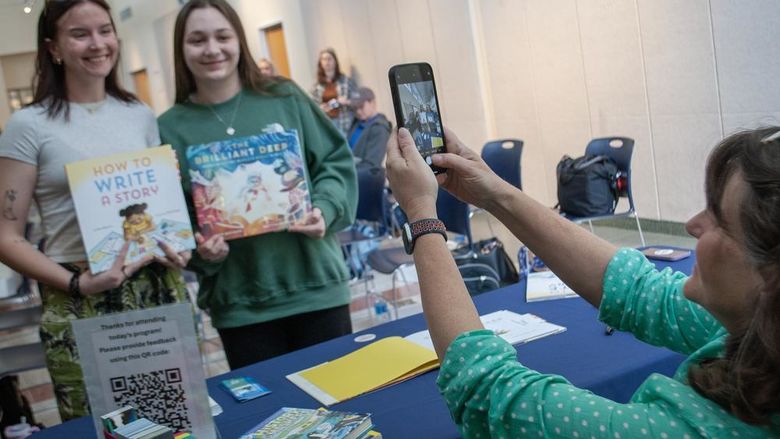
Rukayya Ibrahim, assistant professor of mathematical sciences, served as a faculty mentor for high school student Sarah Gebrezgi in the EnvironMentors program. Ibrahim said exposing the students to an institution of higher learning is great experience for them, especially if they’re going to college to possibly specialize in STEM.
MIDDLETOWN, Pa. — Mane Khachatryan, a second-year biology major at Penn State Harrisburg, said she didn’t really get to delve into science until she came to college. So when she heard about EnvironMentors — a program that helps expose high school students to STEM — she jumped at the chance to help younger students explore the field.
“I wish I had opportunities like this in high school,” she said.
Many of the Penn State Harrisburg students and faculty who signed up to be mentors for high school students through the EnvironMentors program cite a common reason they wanted to participate — the chance to give high school students something they didn’t have themselves.
Penn State Harrisburg began participating in the Penn State chapter of EnvironMentors in 2019. The program links a high school student with an undergraduate student mentor and a faculty mentor for an environmentally themed research project that takes place over the course of the academic year.
While some of the high school students are already interested in STEM, the goal is to reach them early, said Mitch Spear, laboratory manager at Penn State Harrisburg and part of the EnvironMentors leadership team. Through the program, the students are introduced not only to STEM fields, but to college life as well.
Spear said that EnvironMentors gives the high school students early access to college, helping to reduce stress and anxiety over attaining a college degree. In addition to formal mentoring, they have the chance to interact informally with their student and faculty mentors and talk about college life.
By participating in a college program, the high school students gain more experience before they pursue academic degrees — whether they are in STEM or not, he said. Some past participants are now Penn State Harrisburg students, and others have gone on to attend other institutions.
There are big picture reasons to encourage future STEM researchers, too, Spear said.
“I want to see [more] diverse backgrounds in STEM, because we have a lot of challenges that we’re facing that can only be solved with that diversified background in STEM,” Spear said, listing climate change, health disparities and other issues. “The only way we’re going to solve those is to have a diversified workforce.”
Khachatryan served as an undergraduate mentor, alongside faculty mentor Sayed Reza, assistant professor of computer science, for Joy Zaman, a Hershey High School student.
Early in the process, Reza pointed Zaman toward some open data websites to let her explore potential focus areas. Reza has worked with high school students previously, he said, and he found that it is best to help them find a topic that interests them.
"Exploration of open data fuels curiosity which drives research and, ultimately, empowers students to discover and innovate,” Reza said.
Zaman chose to research the environmental implications of electric car usage. The group met frequently, often over Zoom, to discuss the project — examining the data on vehicle registration and air quality and talking about what issues she encountered.
“I try to let Joy take the reins,” Khachatryan said. “She came up with the project idea. I also didn’t want her to feel alone. We also have a group chat. She can ask questions … and Dr. Reza guides us.”
Zaman said the program was a good opportunity to learn skills she’d need later in life.
“Because of our project being centered around data analysis, I was able to learn different ways to utilize helpful applications like Excel,” she said. “Additionally, the symposium was a great way to practice my presentation skills and exposed me to other people and students with great ideas and projects. During the course of finding data for my own project, I was also able to observe interesting findings, making the research portion enjoyable itself.”
Sisters Ariam and Sarah Gebrezgi, both students at Harrisburg High School Sci Tech Campus, participated in EnvironMentors for the second year. Ariam said she found out about EnvironMentors from her high school chemistry teacher.
“I never heard anything like it before,” she said. “I didn’t know high school students could participate in high level research like this.”
Sarah and Ariam met with their undergraduate and faculty mentors together, exploring topics that expanded on their projects from last year. Ariam dug into pollution data, comparing information from Environmental Protection Agency sensors in Harrisburg with data from other smaller sensors in the city, to look for discrepancies. Sarah looked at COVID-19 data in various Pennsylvania counties last year, and this year, she expanded to focus on redlined communities.
They worked with undergraduate biology majors Makaylin Valley and Chelsy-Sippora Funebe.
“It’s been great,” Ariam said. “I’ve learned a lot. I learned some Python (programming language). Knowing how to code is so important in today’s world.”
The EnvironMentors experience culminates in a research symposium, which was held at University Park. That means that in addition to experience with research, the students get a taste of what it’s like to present in a professional setting.
Sarah said that expressing her research and sharing it with an audience was challenging.
“I had to break out of my shell as well,” she said.
Ariam added that the research symposium was a great opportunity to network with researchers throughout Penn State.
“I met and spoke with many professors that were conducting research like mine and ended up learning even more from their findings,” she said.
Rukayya Ibrahim, assistant professor of mathematical sciences, served as Sarah’s faculty mentor. Ibrahim said she’s passionate about outreach, and so, for her, signing up as a faculty mentor was a “no brainer.”
“I grew up … not being able to see someone like me in science,” she said. She added that exposing the students to an institution of higher learning is great experience for them, especially if they’re going to college to possibly specialize in STEM.
Greg Jenkins, professor of meteorology and atmospheric science at Penn State, served as Ariam’s mentor. He said high school students don’t often get the opportunity to do this type of research, much less on a university campus.
The program has benefits for the mentors, too, he said.
“We’re interested in the projects,” he said. “They’re helping us to push our projects forward.”
Ibrahim said the undergraduate student mentors were “awesome” and working with the same high school students two years in a row and watching them grow — both as people and as researchers — was gratifying.
“I am very proud of them, and I have no doubt they'll carry what they learned wherever life takes them,” she said. “As a junior faculty, it has been inspirational to watch my colleagues build and support strong teams throughout the program. I learn so much from them.”
Jenkins said he thinks the program can continue to grow.
“I really feel that there is lots of potential in expanding the program in the Harrisburg area, where there are many interesting environmental, health, science and engineering research problems that are not fully understood but linked together,” he said.








